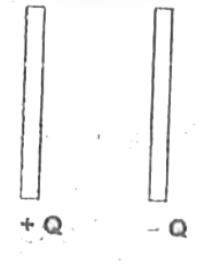A parallel plate capacitor is charged and then isolated. The effect of increasing the plate separation on charge, potential and capacitance respectively are
constant, decreases, increases
constant, decreases, decreases
constant, increases, decreases
increases, decreases, decreases
The correct Answer is:C
To analyze the effect of increasing the plate separation on charge, potential, and capacitance of a parallel plate capacitor that has been charged and then isolated, we can follow these steps:
Step 1: Understanding the Capacitor
A parallel plate capacitor consists of two conductive plates separated by a distance D. When charged, one plate accumulates positive charge +Q and the other accumulates negative charge −Q.
Step 2: Capacitance Formula
The capacitance C of a parallel plate capacitor is given by the formula:
C=ε0AD
where:
- C is the capacitance,
- ε0 is the permittivity of free space,
- A is the area of the plates,
- D is the separation between the plates.
Step 3: Isolated Condition
Once the capacitor is charged and isolated, it means that there is no external circuit connected to it. Therefore, the charge Q on the capacitor remains constant.
Step 4: Effect of Increasing Plate Separation
Now, if we increase the plate separation D:
- From the capacitance formula, if D increases, C decreases because capacitance is inversely proportional to the distance D.
Step 5: Charge on the Capacitor
Since the capacitor is isolated, the charge Q remains constant regardless of the change in plate separation.
Step 6: Potential Difference
The potential difference V across the capacitor is given by:
V=QC
Since Q is constant and C is decreasing (as established in Step 4), the potential V must increase. This is because if the denominator of a fraction decreases while the numerator remains constant, the overall value of the fraction increases.
Summary of Effects
1. Charge Q: Constant (remains the same).
2. Potential V: Increases (because capacitance decreases).
3. Capacitance C: Decreases (due to increased plate separation).
Final Answer
- Charge: Constant
- Potential: Increases
- Capacitance: Decreases
A parallel plate capacitor consists of two conductive plates separated by a distance D. When charged, one plate accumulates positive charge +Q and the other accumulates negative charge −Q.
The capacitance C of a parallel plate capacitor is given by the formula:
C=ε0AD
where:
- C is the capacitance,
- ε0 is the permittivity of free space,
- A is the area of the plates,
- D is the separation between the plates.
Once the capacitor is charged and isolated, it means that there is no external circuit connected to it. Therefore, the charge Q on the capacitor remains constant.
Now, if we increase the plate separation D:
- From the capacitance formula, if D increases, C decreases because capacitance is inversely proportional to the distance D.
Since the capacitor is isolated, the charge Q remains constant regardless of the change in plate separation.
The potential difference V across the capacitor is given by:
V=QC
Since Q is constant and C is decreasing (as established in Step 4), the potential V must increase. This is because if the denominator of a fraction decreases while the numerator remains constant, the overall value of the fraction increases.
1. Charge Q: Constant (remains the same).
2. Potential V: Increases (because capacitance decreases).
3. Capacitance C: Decreases (due to increased plate separation).
- Charge: Constant
- Potential: Increases
- Capacitance: Decreases
Topper's Solved these Questions
- ELECTROSTATIC POTENTIAL AND CAPACITORSBOOK - DC PANDEY ENGLISHCHAPTER - ELECTROSTATIC POTENTIAL AND CAPACITORSEXERCISE - (B) Chapter exercises
17 Videos
- ELECTROMAGNETIC WAVESBOOK - DC PANDEY ENGLISHCHAPTER - ELECTROMAGNETIC WAVESEXERCISE - Sec C
22 Videos
- ELECTROSTATICSBOOK - DC PANDEY ENGLISHCHAPTER - ELECTROSTATICSEXERCISE - Medical entrances gallery
37 Videos
Similar Questions
A parallel plate capacitor is charged and then isolated. On increasing the plate separation
View SolutionA parallel plate capacitor is charged. If the plates are pulled apart
View SolutionA parallel plate capacitor is charged from a cell and then isolated from it. The separation between the plates is now increased
View SolutionA parallel plate capacitor is charged from a cell and then isolated from it. The separation between the plates is now increased
View SolutionConsider a parallel plate capacitor having charge Q. Then,

View SolutionA parallel plate capacitor is charged and then the battery is disconnected. When the plates of the capacitor are brought closer, then
View SolutionA parallel plate capacitor of capacitance C is charged to a potential V and then disconnected with the battery. If separation between the plates is decreased by 50% and the space between the plates is filled with a dielectric slab of dielectric constant K=10. then
View SolutionA parallel plate capacitor is charged and the charging battery is then disconnected. If the plates of the capacitor are moved farther apart by means of insulating handles:
View SolutionTwo plates of a charged parallel plate capacitor are pulled apart with the help of insulating handles, till their separation is doubled.
Compare the new electrostatic potential energy of the capacitor with the old
View SolutionA parallel plate capacitor is charged to a potential difference of 10 volts. After disconnecting the battery, distance between the plates of capacitor is decreased by using nonconducting handles. The potential difference between the plates will
View Solution
